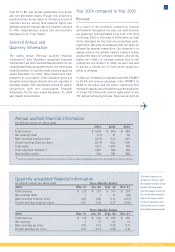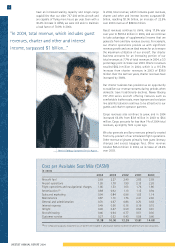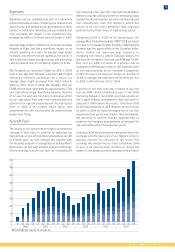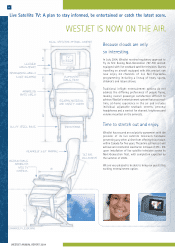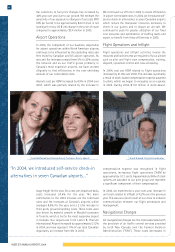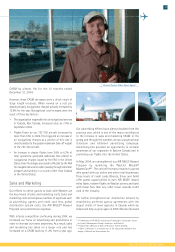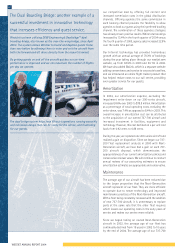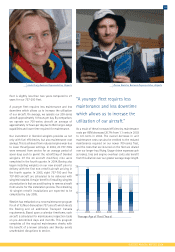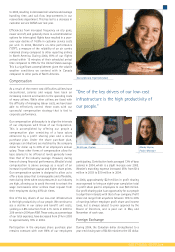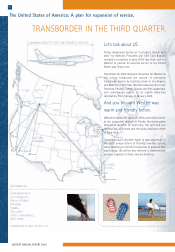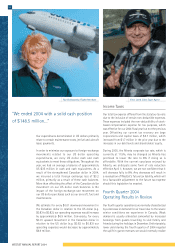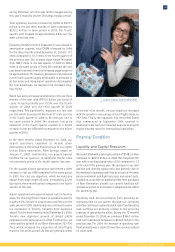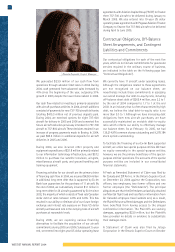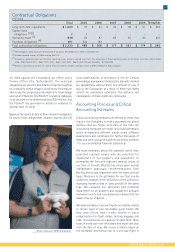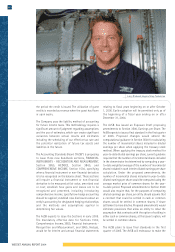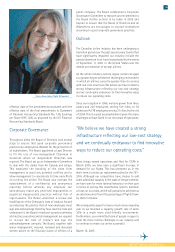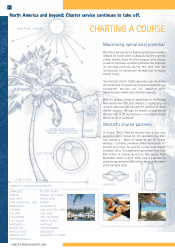Westjet 2004 Annual Report Download - page 31
Download and view the complete annual report
Please find page 31 of the 2004 Westjet annual report below. You can navigate through the pages in the report by either clicking on the pages listed below, or by using the keyword search tool below to find specific information within the annual report.
WESTJET ANNUAL REPORT 2004
to 2003, resulting in decreased call volumes and average
handling time, and call-flow improvements in our
reservations department. This has led to a decrease in
customer service CASM over last year.
Efficiencies from increased frequency on city pairs,
newer aircraft, and generally more re-accommodation
options for interrupted flights have resulted in a year-
over-year decline of 16.8% in customer service costs
per unit. In 2004, WestJet's on-time performance
(“OTP”), a measure of the reliability of an air carrier,
remained strong compared to other reporting airlines
in North America. During 2004, 81% of our flights
arrived within 15 minutes of their scheduled arrival
time compared to 78% for the United States average.
This is a significant accomplishment given the volatile
weather conditions we contend with in Canada
compared to other parts of North America.
Compensation
As a result of the recent cost difficulties airlines have
encountered, salaries and wages have been an
increasing concern and burden to the operating costs
of many airlines. While other airlines are faced with
the difficulty of managing labour costs, we have been
able to effectively control these costs with our
successful compensation strategy that is tied to
corporate performance.
Our compensation philosophy is to align the interests
of our employees with those of our Corporation.
This is accomplished by offering our people a
compensation plan consisting of a base salary
enhanced by a profit sharing plan and a share
purchase plan. Under the share purchase plan,
employee contributions are matched by the company
dollar for dollar up to 20% of an employee's annual
salary. These other forms of compensation allow for
base salaries to be offered at levels generally lower
than that of the industry average. However, during
times of strong financial performance, WestJet's total
compensation is above average as a result of an
increase in profit share payout and higher share prices.
Our compensation system is designed to allow us to
offer a base salary that is manageable and affordable,
even during times when cost pressures in our industry
are high, allowing us to avoid the need to extract the
wage concessions other airlines must request from
their employees during difficult times.
One of the key drivers of our low-cost infrastructure
is the high productivity of our people. We continue to
see a decline in our salary and benefit unit costs,
yielding a 2.8% reduction from 2.15 cents in 2003 to
2.09 cents in 2004 per ASM. These costs, as a percentage
of our total expenses, have decreased from 21% in 2003
to approximately 19% in 2004.
Participation in the employee share purchase plan
remains constant with over 86% of our employees
participating. Contribution levels averaged 13% of base
salaries in 2004, which is a slight increase over 2003.
WestJet's matching expense increased 35% from $14
million in 2003 to $19 million in 2004.
In 2004, approximately $2.9 million in profit sharing
was expensed to bring an eight-year cumulative total
in profit share paid to employees to over $63 million.
Our profit sharing plan is an opportunity for our people
to align their interests with that of our company. Profit
share can range from anywhere between 10% to 20%
of earnings before employee profit share and income
taxes, but is always subject to prior approval by the
Board of Directors, and is paid out in May and
November of each year.
Foreign Exchange
During 2004, the Canadian dollar strengthened to a
year-end closing rate of $0.83 relative to the US dollar.
Rick Krupa, Captain Mandy Hryciw,
Project Manager
Nancy Menard, Flight Attendant
“One of the key drivers of our low-cost
infrastructure is the high productivity of
our people.”
31


